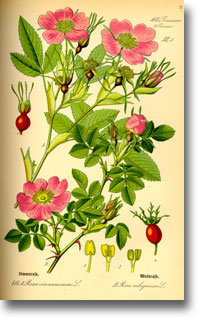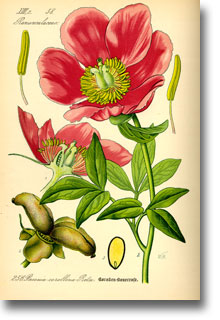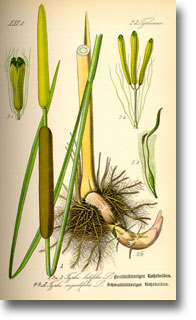

 General Questions
General Questions
What is a multiple-entry key?
Unlike a traditional dichotomous key that begins with a single question or choice, a multiple-entry key for plants has no defined starting point and no specific order of data collection. Faced with an array of questions related to habit, habitat, leaves, flowers, or fruit, each user chooses a route through the process and, by doing so, learns which features are most effective for identification. By entering more and more data into the key, users can steadily narrow the list of possibilities through a process of elimination. Eventually, if enough details are visible in the live plant or the illustration, a user should be able to reach a single, matching identification.
What is a plant family?
Ever since Carl Linnaeus published
Species Plantarum in 1753, botanists have been trying to make sense of the plant kingdom by arranging it into a series of logical subcategories. A "plant family" was originally only seen as a group of plants that shared certain morphological features, such as opposite leaves or fused petals. Following the work of Charles Darwin, the concept of plant taxonomy evolved into a system of organization based on common ancestries, but morphological features remained the primary means of deciphering such relationships. On the basis of such features alone, the flowering plants, or angiosperms, were divided up into several hundred families.
In recent years, DNA analysis has allowed scientists to determine the ancestry of plant species with greater precision. While the resulting evidence has forced some changes in the classification system, the families set up in previous centuries have proven remarkably resilient. By and large, it is still possible to identify flowering plants to the correct family based on macroscopic features alone. In the absence of portable DNA analysis tools, the collection and interpretation of visual evidence remains the primary means of plant identification in the field.
What is an APG III family?
To try and bring some consistency to the classification of flowering plants, the Angiosperm Phylogeny Group (or APG) was established in the late 1990's. The group examines the latest published scientific literature to determine a consensus view of the relationships among the angiosperms. To date they have published three classification systems, the newest of which - APG III - came out in 2009. This system is based on the latest molecular and genetic data and is likely to be the basis for most floras and field manuals in the future. We have therefore used that system to organize the families in our site. To help users of older systems, we have included links to the Wikipedia pages for other classifications on our
Families page.
For more information on the APG III system, see: An update of the Angiosperm Phylogeny Group classification for the orders and families of flowering plants: APG III, Botanical Journal of the Linnean Society, 2009, 161, 105–121.
Which families are included in this key?
Because this site is being developed at the University of Florida, our initial goal was to include the 196 flowering plant families known to exist in the natural areas of the state. Now that those are finished, we are steadily expanding the key to cover other families found in North America. The ultimate goal is to include all 415 families of angiosperms worldwide. You can see our current list of families by going to the
Families page.
Can any plant in those families be successfully identified by FloraGator?
Well... probably not any plant. Because the APG III system is based on evolution, rather than physical characteristics, there are a few families that are genetically distinct but very similar in appearance. To distinguish between those families on morphological features alone, you would probably need some very specialized details that aren't in our key. So FloraGator might only be able to narrow those plants down to a choice of two or three families. But, those exceptions aside, the vast majority of plants in the families covered by this site should key out successfully.
Which characters are included in this key?
In designing the key, we chose 220 pieces of information that we thought would be most useful for botanists trying to identify plants in the field. We included some features, like placentation, that will probably require a hand lens, but we left out anything that would require a microscope or a chemical test. We also left out some features that could be highly subjective - like colors, tastes, smells, and textures - and we tried to give extra emphasis to the features that could be counted.
The decision to leave out location was the toughest call. In most cases, a field botanist can rule out more than half of the APG III families just by knowing where a certain plant is growing. But climate change is going to play havoc with plant habitats and ranges in the coming years, and we wanted our key to work for the unexpected invaders as well as the longstanding residents. And, ultimately, FloraGator is an exercise in using the anatomy of the plants themselves to make an identification. So we left location out of the key.
Would FloraGator work world-wide?
The data that are entered for each family are intended to cover the full, world-wide diversity of the family. Theoretically, a member of Solanaceae in South Africa or Brazil should key out as accurately as a member of the same family in Florida. (And we would love to get feedback on whether that actually proves true in practice!)
- back to top -

 Student Questions
Student Questions
Why is the key so technical? Can't you dumb it down a bit?
The terms that describe the parts of a plant tend to be very arcane but also very precise. It would be difficult to describe placentation or leaf venation in more familiar language without losing some of that precision. More importantly though, one of the main goals of this site is to help students learn the vocabulary of modern botany by giving them a chance to actively use it and apply it. (Think of it as a foreign language immersion program.) So we wouldn't be doing you any favors if we took out the language of modern botany and replaced it with something else. Generally speaking, the terms that are in the key are the ones that you will really need to know if you plan to spend any time identifying plants.
Help! There's no glossary! What do terms like "perigone tube" mean?
If you need to find the definition of a term, there are a few sources we would recommend. The first would be Chapter 9 of the 2nd edition of
Plant Systematics by Michael Simpson. It gives a very thorough review of plant terminology, and it was the primary source we used in writing the key. We would also recommend the glossary at the back of
Guide to Flowering Plant Families by Wendy Zomlefer. It includes some very nice drawings to illustrate each term. And we also really like
The Cambridge Illustrated Glossary of Botanical Terms which also gives nice drawings to illustrate a wide variety of terms.
All three of those books are big, glossy, and expensive. If you just need a cheap, small reference to carry around in the field, we would recommend How to Identify Plants by H.D. Harrington. It's widely available in paperback and it usually costs less than $10. And if you just need an online reference while you're using FloraGator, you should check the list of plant characteristics in the Virtual Field Herbarium maintained by the Oxford Plant Systematics and Diversity research group. They do a nice job of defining things.
(So is "perigone tube" defined in any of those sources? Nope. It's a really obscure term for a tube formed by the fusion of the perianth parts in a monocot flower. A perigone tube looks and functions like a hypanthium but it's actually formed in a different way and so it isn't a homologous structure.)
What do the numbers in the results list mean?
The FloraGator database uses a ternary system to record the diversity within each plant family. That means, for each of the 220 features listed in the key, the database records either a 0 for "absent," a 1 for "rare," or a 2 for "common." As a user fills out the form, the key eliminates any family in which the feature never appears. The remaining families are ranked according to total score, so that families in which the features are common will appear first. In this way, the key allows for the odd exceptions that are present in most families while still steering users toward the most likely answers.
What do I need to turn in?
Your instructor will probably want to see the full results from your keying exercise, including all of the characters you selected and the resulting family or families returned by the key. If you just click once in the "Results" window after you finish keying out a plant, your browser should automatically select the full list of characters and families. You can copy that, paste it into an e-mail, and send it to your instructor.
Can't I just cheat if I recognize the plant in the picture?
No, not really. The point of the exercise isn't to identify the family, but to identify the visible features that would lead to an accurate identification. Even if you think you know what family you're seeing, you still need to find and identify the features that key it out in FloraGator. From the results you turn in, the instructor is going to see whether you correctly counted the stamens, carpels, petals, and so forth. A family description might tell you the range of possibilities for those numbers, but there's no source that will tell you what is visible in the botanical illustration or in the live plant material you're seeing in lab. You've got to find that out for yourself.
(Side note: You might also want to be careful about jumping to a family identification based on the recognition of a plant. There are many people who can identify a daylily by sight, but there are very, very few people who can tell you where it belongs in the APG III families. Hint: it's not in Liliaceae.)
- back to top -

 Instructor Questions
Instructor Questions
What kinds of courses might use FloraGator?
Any college-level course where students are expected to use and understand botanical terminology would be a good fit for this site. Some of the courses might include Botany, Field Botany, Plant Anatomy, Plant Identification, Plant Taxonomy, and Plant Systematics.
What are students likely to learn from using FloraGator?
In its current form, FloraGator provides an interactive keying exercise where students can apply botanical terminology to practice the collection and interpretation of morphological evidence. Through the process of using the site, we hope that students will learn...
- to apply modern botanical terminology,
- to identify plant structures and patterns,
- to interpret macroscopic, morphological evidence of plant evolution,
and, ultimately,
- to independently and swiftly assemble a body of evidence leading to an accurate family identification.
How can I use FloraGator in my courses?
We envision FloraGator being used for both in-class and out-of-class assignments. For an in-class lab assignment, students could use laptops and work in small groups to make an identification. They could use live plant material or use one of the botanical illustrations provided in the key. (If you are interested in using poster-size illustrations for this kind of project, please contact us and we can send you the high-resolution files.) Students could then present their results to the class and discuss their identifications.
For a homework assignment, students can use the key to identify one or more of the botanical illustrations that we have provided as samples. Students can highlight the results of the key and send those results to the instructor to complete the assignment. In that way, instructors can see both the choice of characteristics and the resulting family identification. The results of this keying exercise would help instructors identify gaps in a student's understanding of plant anatomy.
In future years, as the database expands and improves, we plan to develop a version of this key that will work on smartphones and tablet computers. In this way, the site can become a practical teaching tool for plant identification in the field. With a handlens and a cell phone, a student can approach an unknown plant and decipher the clues that will lead to an accurate identification. We think this will be an exciting tool for plant discovery.
If you are an instructor using FloraGator in your class, please write to us and let us know how it goes! We would be excited to hear how the key is being used and how it could be improved. (We would also be very excited to hear from students who are using FloraGator in their classes!)
- back to top -

 General Questions
General Questions Student Questions
Student Questions Instructor Questions
Instructor Questions © Department of Environmental Horticulture, College of Agricultural and Life Sciences,
University of Florida
© Department of Environmental Horticulture, College of Agricultural and Life Sciences,
University of Florida

